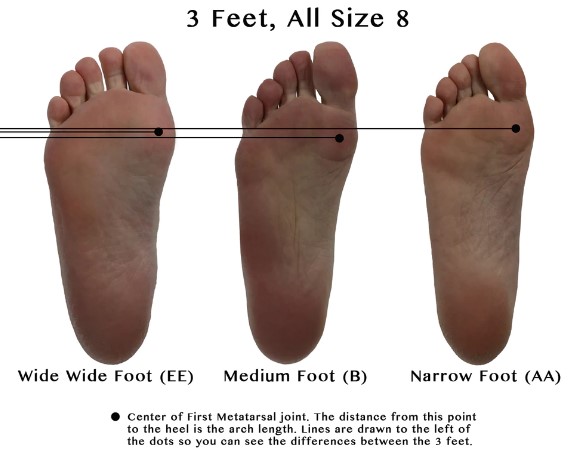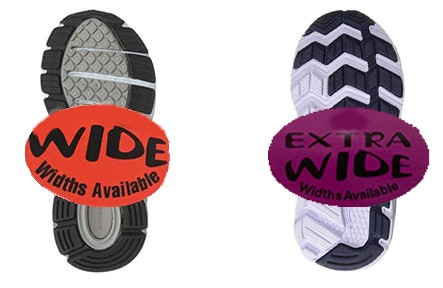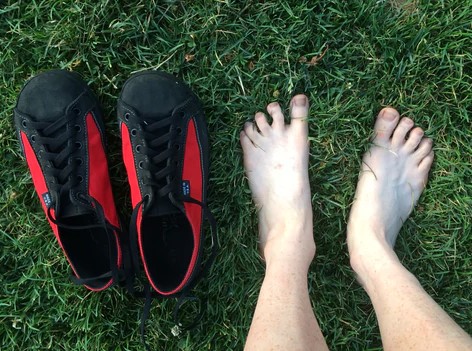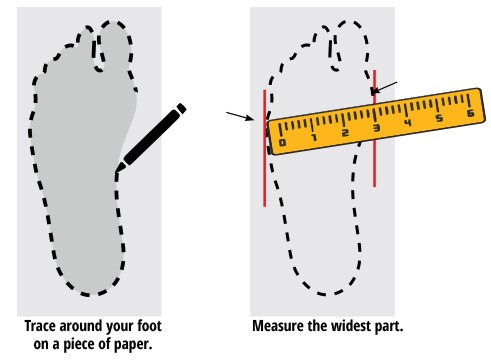Almost everyone out there usually focuses their shoe sizes on the length without considering the width. But in some circumstances, using shoes of wider sizes could be a must. This is only possible where you know your feet’ width. So, if you’re asking, can I wear wide fit shoes with normal feet? That there’s a reason you need to do so.
It’s possible to wear wide-fit shoes with normal feet. They are the perfect options for obese and diabetic patients that require shoes with wider fittings. Also, wide-fit fit shoes are great during pregnancy or foot infections like calluses and bunions.
Keep reading this article to learn more about shoe width and its measurement. Also, you’ll find the difference between wide shoes and regular ones, why people need wide-fits shoes, and more. Let’s roll down!
Article Summary:
- It’s possible to wear wide-fit shoes with normal feet as they provide more comfort and space for the toes.
- The range of shoe width differs for both men’s and women’s measurements, running from the widest to the narrowest size.
- There are different reasons people wear wide fit shoes, including pregnancy, health issues, and foot infections.
- To choose the correct shoe size, you must know how to measure the width shoe and its height.
Can I Wear Wide Fit Shoes With Normal Feet?
It’s possible to wear wide-fit shoes with normal feet if you’re comfortable using them during your movement. They could be the best options in some circumstances like pregnancy or conditions with foot infections.
However, some brands don’t include shoe width measurements for their shoe sizes. So, it could be quite difficult for many people to pick out their correct shoe width sizes. This could lead to a person with normal feet selecting shoes with wider fittings.

So, you may be wondering can I wear wide fit shoes with normal feet? It’s possible to do so. We’ll look at some conditions where you can wear wide-fit shoes with normal feet.
Conditions for Wearing Wide Fit Shoes With Normal Feet
- Wearing wide-fit shoes with normal feet is more comforting and easier during long-distance walks.
- They provide more space for the breathability of the shoes and increase airflow inside the shoes.
- Wide fit shoes ensure that your toes are freer to move without creating pains or triggering foot complications.
- You may have to use a wider fitting shoe if you have some prevailing health issues like diabetes.
- An obese person would have no choice but to use wide-fit shoes.
- There could be a situation where you mistakenly bought shoes with wider fittings and could return them. Hence, you may be left with the option of using them.
Despite the several conditions that could permit the use of wide-fit shoes, they might pose some risks for some activities. They are a great disadvantage for walking and running on slippery surfaces like grass as walking or running in the grass requires specialized shoes. They could make you lose your footing and stubble with heavy injuries.
Moreover, wide fit shoes are not suitable for sports. The extra room within the shoes would create discomforting movements for your feet and toes. Also, they could expose you to the dangers of muscle and nerve aggravation and pains.
Using the right fitted shoes would provide the right balance for all activities and on all types of surfaces. Also, you would get a firmer grip and less risk of pains and injuries. Remember that the shoes mustn’t necessarily be tight to avoid foot blisters.
Factors to Consider for Shoe Width
When considering your shoe size, the shoe width matters. Using the wrong shoe width could leave lasting physical and health issues. Hence, you must choose the right width fitting always.
Here are some of the factors to consider for your shoe width.
- Comfort
- Support
- Usability
- Protection
- Foot Condition
Explained About Shoe Width
Shoe width is the measurement of the forefoot that gives the widest part of the foot. Usually, the shoe width comes as an alphabet together with the length size of the shoe.

This means that for shoe measurements, the length size is given as numbers and measures your foot length. Conversely, the width size is given as letters and measures the wideness of your foot. So, if you get a shoe size of 35B, it means that the size of the length is 35 while the width is B. Also, a shoe size of 35E has a length size of 35 while the width is E.
The range of shoe width runs from the widest to the narrowest EEE, EE, E, D, C, B, A, AA, and AAA. You can still get other sub-sizes for both wide and narrow shoes. In such cases, there would be additional letters that show how wider or narrower the width could be.
Generally, the width sizes for men’s and women’s shoes indicate some variations. While the men’s shoe width of B indicates narrow, the women’s narrow shoe width measurement is A or 2A. Also, the men’s shoe widths are from A to high sub-sizes of E while the women’s are from sub-sizes of A to E. So, it’s important to understand shoe widths grading and their indications to help you while choosing the right size.
Difference Between Wide Shoes And Regular Shoes?
The difference between wide shoes and regular shoes is the variations due to the increase in the toe box and forefoot. So, a wider shoe will increase in width than a regular shoe with a minimum of a ¼ inch.
Both the regular shoes and wide shoes have the same measurement for length. Also, the heel widths for the two shoe types in most cases are similar but may sometimes differ. The main difference comes from the forefoot and toe box, which will become wider as the size increases.

For instance, an E width will differ from a D width of the same length with an additional ¼ inch. This means that the E size is wider by ¼ inch, equivalent to 1mm. However, some brands could make some variations on the difference based on their specifications.
Furthermore, differences in sizes (both in length and width) could rise based on the purpose of the shoes. The categorization of dressing shoes and running shoes are not similar. You could use a measurement of 10 in dressing shoes but 10.5 or higher in running shoes. In this case, you would not be talking about wide-fit shoes since they are of different types.
The size ratings for the two types of shoes are different since running shoes tend to go with higher ratings. Also, the slight difference accounts for the required balance, support, and comfort that you must get from running shoes. This’s because sporting activities are already strenuous and don’t need more pressure from tighter shoes.
Shoe Width Categorizations
Both the men’s and women’s shoe widths can be categorized using two systems:
Alphabet System
Alphabets are used to mark the different width measurements of men’s and women’s shoes. The sizes are as follows:
- AA to AAAA…. (2A, 3A, 4A, and 4A+ )
- A
- B
- C
- D
- E
- EE to EEEE…. (2E, 3E, 4E, and 4E+)
Word System
Just as the name goes, the system uses words for marking the width measurements for the shoe sizes of men and women. The sizes are as follows:
- Extra Narrow
- Narrow
- Normal or Medium or Standard
- Wide
- Extra Wide
Comparison Table for Men’s and Women’s Shoe Width Sizes -Wide and Regular Shoes
| Width Size | Men’s Width | Women’s Width |
| 3A to 4A (3A, 4A, 4A+) | – | Extra Narrow (There would be an additional ‘A’ for cases with narrower shoe width) |
| A to 2A | Extra Narrow (In most cases, it’s rare to get men with narrower width sizes of 2A and below) | Narrow |
| B | Narrow | Standard or Normal (This indicates the women’s regular or most common width measurement) |
| D | Standard or Normal (This indicates the men’s regular width size) | Wide |
| E TO 2E | Wide | Extra Wide (This is usually found in women with wider forefoot and toe box. In some cases, it could be for diabetic patients) |
| 3E to 4E+ (3E, 4E, 4E+) | Extra Wide (This indicates more increase in the toe box and forefoot for the male folk. Hence, the width measurement would have an additional ‘E’ progressively) | – |
Why Do People Need Wide Fit Shoes?
Wide-fit shoes offer comfort with the extra space for the feet and toes to move freely without constraints and pains. Also, they could be the perfect option for some conditions like diabetes, pregnancy, and handling corns and blisters.

Here are some of the reasons people may need wide-fit shoes in detail.
More Comfort and Balance
Proper balance and comfort for your feet and leg matter a lot with the choice of shoe sizes that you make. Using tight-fitted shoes create more tension and discomfort in the feet. In most cases, it could be difficult to walk properly using such tight shoes.
Conversely, wide-fit shoes provide you with all the flexibility you need. They would allow your feet and toes to spread out freely without any restriction. This creates adequate balance and comfort for your feet irrespective of the length of time you may wear the shoes.
Age advancement and Weight Addition
Older people would always crave wider fitting shoes. As one advance in age, the body’s muscles weaken and tend to sag. This increases the flesh tendons and ligaments and could cause the shoe width to also increase. Hence, there’s a need for wide-fit shoes.
With weight additions, it’s inevitable that the shoe width of the person would change. The added weight cuts across the feet and widens the toes box and forefoot the more. So, using a wide-fit shoe is the only option for such a person.
Creating Space for Breathability
One of the major benefits of using wide-fit shoes is the provision of space for feet’ breathability. It allows more airflow within the interior of the shoes and helps the feet to flex properly. With the space, your feet will have less sweat and will reduce the possibility of getting fungal infections.
Also, you can easily wriggle your toes to maintain normal blood circulation through your feet and other body parts. This serves as a subtle measure to avoid compartment syndrome.
More Room for Insole
If you’re one of those people that love wearing flat shoes always, you may need to have a rethink. Low shoes with little or no insoles expose you to the risks of fallen arches. This is quite painful if you would be making use of your feet for the greater part of the day.
Your possible solution lies in using wide-fit shoes that would give you more room to add insoles. Also, the wider shoe would ensure that your feet spread out to avoid the collapse of your arches.
Preventing Blisters, Corns, and Bunions
Over-fitted shoes are no good for you for whatever reasons. It would create more pressure between your feet or toes and the shoes. Hence, increased friction would lead to blisters, and with time, they would turn to corns. In most severe cases, you will be left with scars even after treatment.
Using wide-fit shoes gives more space within your shoes. This would eliminate the friction between your toes or feet and the shoes and the occurrence of blisters and corns.
When it comes to bunions, it’s a foot infection that could accelerate with the wrong shoe fitting. Though it could be hereditary in most cases, using tighter and very narrow shoes would aggravate its growth. The best practice in lessening its impact is through a wider fitting shoe. This would create the necessary space for it as well as cut off its further expansion.
Handling of Health Problems
Some health problems could cause the swelling of the body and feet resulting in the patient having wider feet. In some circumstances, the lymphatic system could fall in its processes leading to fluid imbalance. If the body retains more fluid, the patient could get wider feet.
Examples of such health conditions include obesity, kidney diseases, diabetes, and others. Such patients would have to use wide-fit shoes due to their wider feet.
Pregnancy Adjustment
Pregnancy is one of the events in life that could change your general body size. In most cases, the person could have swollen feet with increased body weight. Also, the secretion of special hormones during pregnancy activates the weakening of some ligaments. Hence, the person could have wider feet than the normal size.
In such cases, wide-fit shoes would be the only properly fitting for the pregnant woman. However, this would only be for the temporary period of pregnancy and would correct after child delivery.
How To Find Comfortable Wide-Width Shoes?
To find comfortable wide-width shoes, measure the position of the toe box and the forefoot. This provides the measurement for the widest portion of the shoe.
In some cases, it’s not quite easy to select a shoe width. This is because some brands may not include the width measurements in their sizes. So, for some people, getting shoes in bigger sizes is the surest way to find comfortable wide-width shoes.
Also, you can personally measure your shoe width using a measuring tape. Then, add an extra 1mm to the actual value of your feet width to get comfortable wide-width shoes. Generally, wide-width shoes must not be more than 2mm greater than your real width size.
How To Measure Width Shoe?
You can measure your width from the forefoot to the toe box using a measuring tape.

The following steps are used to measure the width shoe:
- Place a measuring tape on the ground and stand barefoot on it.
- Roll the measuring tape around your feet.
- Ensure that the tape goes through your forefoot and the toe box.
- Note the width size in millimeters by marking the tape.
- Then, use any suitable feet width chart to calculate the right width value.
Bottom Line
Going through this article provides you with the necessary guidance on shoe width. Also, it considers the question, can I wear wide-fit shoes with normal feet? Though you can wear wider shoes with normal feet, they may not provide the right balance and comfort.
Using the correct shoe fitting is the best option for maintaining healthy and strong feet. However, if you must wear wide-fit shoes with normal feet, always consider balance, support, comfort, and flexibility.
